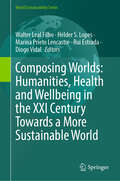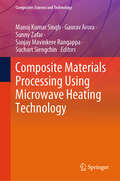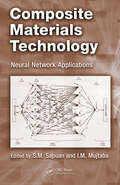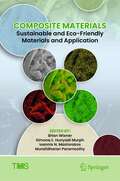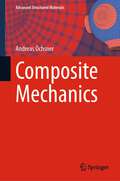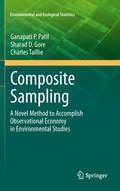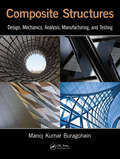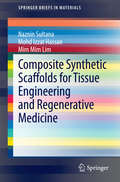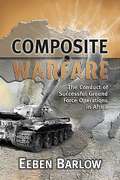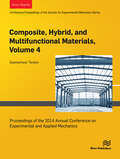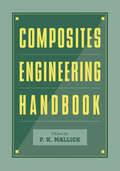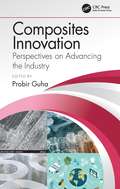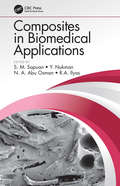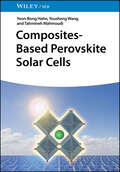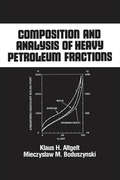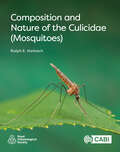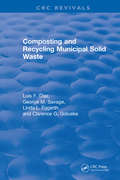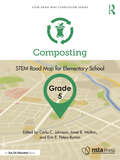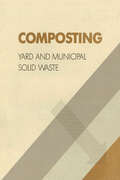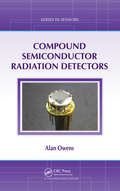- Table View
- List View
Composing Worlds: Humanities, Health and Wellbeing in the XXI Century Towards a More Sustainable World (World Sustainability Series)
by Walter Leal Filho Hélder S. Lopes Marina Prieto Lencastre Rui Estrada Diogo VidalThis book provides an interdisciplinary exploration of how the humanities, social sciences, and health sciences can contribute to addressing the pressing challenges of the Anthropocene. From climate change and biodiversity loss to environmental degradation and public health threats, the book examines the interconnected crises of our time and offers innovative frameworks for fostering sustainability, resilience, and equity. It highlights the cultural, ethical, and philosophical dimensions of these issues to underscore the importance of collaboration across disciplines to shape a just and sustainable future. Key topics include the role of art, literature, and philosophy in raising environmental awareness, the impact of urban green spaces on social participation and health, and the integration of mental health into sustainability discussions. The book also explores eco-anxiety, digital technologies, and citizen science as pivotal aspects of contemporary socio-environmental challenges. Through case studies and theoretical insights, it demonstrates the value of combining scientific expertise with cultural and ethical understanding to create effective solutions for global and local problems. This book is a valuable resource for researchers, students, policymakers, and practitioners in the humanities, social sciences, health, and environmental studies. It invites readers to rethink their relationship with nature and society while inspiring transformative actions that prioritize sustainability and equity. Whether addressing global crises or local community initiatives, this work offers practical insights and fresh perspectives for anyone committed to building a healthier, more sustainable future.
Composite Materials Processing Using Microwave Heating Technology (Composites Science and Technology)
by Suchart Siengchin Gaurav Arora Sanjay Mavinkere Rangappa Manoj Kumar Singh Sunny ZafarThis book covers all aspects of composite materials processing and manufacturing using microwave heating technology and their applications in various industrial processes. Depending in the processing and material used, the composites are divided into three major segments: Metal matrix composites (MMCS), ceramics composites (CMCS), and polymer matrix composites (PMCS), respectively. During the manufacturing process of these composite materials, conventional heating technologies are used in which the heat is transferred from the electrical resistance coils to the material via conventional modes of heat transfer. Issues like non-uniform temperature distribution, poor curing efficiency, generation of the in-process scrap, long process cycle, high energy consumption and cost make traditional manufacturing route a difficult choice to select. Recently, microwave-assisted heating has emerged as a promising route for the fabrication of composites as a cost-effective environmentally sustainablemanufacturing process that yields improved mechanical properties which is the main topic of this book. It looks into the mechanism, salient features, and important aspects of microwave heating and their interaction with different composites materials. It also presents other manufacturing processes of various composites using microwave heating during casting, drilling, recycling, sintering, material joining, surface engineering. This book will appeal to students, researchers and scientists working in the area of composite materials processing and manufacturing.
Composite Materials Technology: Neural Network Applications
by S. M. Sapuan I. M. MujtabaArtificial neural networks (ANN) can provide new insight into the study of composite materials and can normally be combined with other artificial intelligence tools such as expert system, genetic algorithm, and fuzzy logic. Because research on this field is very new, there is only a limited amount of published literature on the subject.Compiling in
Composite Materials: Science and Applications (Engineering Materials and Processes)
by Deborah D. ChungThe first edition of "Composite Materials" introduced a new way of looking at composite materials: covering composites in accordance with their functions. This second edition expands the book's scope to emphasize application-driven and process-oriented materials development. This tutorial-style reference book examines both structural composite materials and functional composite materials, as needed for a substantial range of applications. The emphasis on application-driven and process-oriented materials development is enhanced by a large amount of experimental results that provide real illustrations of composite materials development. "Composite Materials" is an essential book for researchers and engineers who are interested in materials development for industrial applications. It has a vibrant yet functional approach, making it suitable for both students and practitioners, and provides a full explanation of all of the fundamental concepts related to the structural and functional properties covered.
Composite Materials: Sustainable and Eco-Friendly Materials and Application (The Minerals, Metals & Materials Series)
by Simona E. Hunyadi Murph Brian Wisner Ioannis N. Mastorakos Muralidharan ParamsothyThis collection covers innovations in the field of composite materials with a specific focus on eco-friendly and environmentally sustainable systems. All composite fields are explored, including polymer, metal, and ceramic matrix composites with an emphasis on sourcing raw materials in a sustainable way as well as the development of composite materials for environmental sustainability. Topics will include the development of new materials for structural applications, reduction in energy consumption, and increased component life along with discussions of novel methods to reuse existing materials. Additional topics include, but are not limited to:· Naturally Sourced Materials feedstock · Recycled Material feedstock, · Application of composite for reduced carbon footprint · Development of novel materials to repurpose waste from other areas
Composite Mechanics (Advanced Structured Materials #184)
by Andreas ÖchsnerThis book in the advanced structured materials series provides first an introduction to the mircomechanics of fiber-reinforced laminae, which deals with the prediction of the macroscopic mechanical lamina properties based on the mechanical properties of the constituents, i.e., fibers and matrix. Composite materials, especially fiber-reinforced composites, are gaining increasing importance since they can overcome the limits of many structures based on classical metals. Particularly, the combination of a matrix with fibers provides far better properties than the constituents alone. Despite their importance, many engineering degree programs do not treat the mechanical behavior of this class of advanced structured materials in detail, at least on the bachelor’s degree level. Thus, some engineers are not able to thoroughly apply and introduce these modern engineering materials in their design process. The second part of this book provides a systematic and thorough introduction to the classical laminate theory based on the theory for plane elasticity elements and classical (shear-rigid) plate elements. The focus is on unidirectional lamina which can be described based on orthotropic constitutive equations and their composition to layered laminates. In addition to the elastic behavior, failure is investigated based on the maximum stress, maximum strain, Tsai-Hill, and the Tsai-Wu criteria. The introduced classical laminate theory provides a simplified stress analysis, and a subsequent failure analysis, without the solution of the system of coupled differential equations for the unknown displacements in the three coordinate directions. The book concludes with a short introduction to a calculation program, the so-called Composite Laminate Analysis Tool (CLAT), which allows the application of the classical laminate based on a sophisticated Python script.
Composite Sampling: A Novel Method to Accomplish Observational Economy in Environmental Studies (Environmental and Ecological Statistics #4)
by Sharad D. Gore Ganapati P. Patil Charles TaillieSampling consists of selection, acquisition, and quantification of a part of the population. While selection and acquisition apply to physical sampling units of the population, quantification pertains only to the variable of interest, which is a particular characteristic of the sampling units. A sampling procedure is expected to provide a sample that is representative with respect to some specified criteria. Composite sampling, under idealized conditions, incurs no loss of information for estimating the population means. But an important limitation to the method has been the loss of information on individual sample values, such as, the extremely large value. In many of the situations where individual sample values are of interest or concern, composite sampling methods can be suitably modified to retrieve the information on individual sample values that may be lost due to compositing. This book presents statistical solutions to issues that arise in the context of applications of composite sampling.
Composite Structures: Design, Mechanics, Analysis, Manufacturing, and Testing
by Manoj Kumar BuragohainThe primary objective of this book is to bridge this gap by presenting the concepts in composites in an integrated and balanced manner and expose the reader to the total gamut of activities involved in composite product development. It includes the complete know-how for development of a composite product including its design & analysis, manufacture and characterization, and testing. <P><P>The book has fourteen chapters that are divided into two parts with part one describing mechanics, analytical methods in composites and basic finite element procedure, and the second part illustratesr materials, manufacturing methods, destructive and non-destructive tests and design.
Composite Synthetic Scaffolds for Tissue Engineering and Regenerative Medicine (SpringerBriefs in Materials)
by Naznin Sultana Mohd Izzat Hassan Mim Mim LimThis book addresses important biomaterials which are commonly used to fabricate scaffolds and it describes two major protocols employed in scaffold fabrication. Tissue engineering or regenerative medicine aims at restoring ex-novo tissues and organs whose functionality has been compromised as a consequence of diseases or traumatic events. The innovative concept underlying tissue engineering is the use of autologous cells, obtained from a biopsy of the patient. Cells are seeded on a porous scaffold which has the role of supporting and guiding cells towards the development of tissue-like structures as well as providing a platform for the delivery under controlled condition of growth factor release, etc. The successful manufacture of scaffolds for tissue engineering applications is crucial. In this book, these biomaterials are discussed. The book also covers illustrated examples, structure and properties of scaffolds, cellular interactions and drug delivery.
Composite Warfare: The Conduct Of Successful Ground Force Operations In Africa
by Eeben BarlowComposite Warfare presents African soldiers and scholars with a true African ‘Art of War’. As a continent, Africa presents her armies with a vast, dynamic and multidimensional operating environment. It has numerous complex and diverse ethnic, religious, cultural and tribal interests and loyalties, along with many multifaceted threat-drivers coupled to varied and infrastructure-poor terrain plus vast climatic variations. The continent is, furthermore, characterized by numerous half-won conflicts and wars fought by incorrectly structured, inadequately trained and ill-equipped armies. For many reasons, these forces have difficulty adapting to the complex, demanding and rapidly changing environments they do battle in. Similarly, the armies have difficulty in decisively defeating the various threats they face. Many of these problems stem from the fact that numerous modern-day African armies are merely clones of the armies established by their once-colonial masters, their Cold War allies or their new international allies. Many of the principles and tactics, techniques and procedures they were – and still are – being taught relate to fighting in Europe and not in Africa. Some of these concepts are not even relevant to Africa. This book is intended as a guide and textbook for African soldiers and scholars who wish to understand the development of hostilities, strategy, operational design, doctrine and tactics. It also illustrates the importance of nonpartisanship and the mission and role of the armed forces. Officers, NCOs and their subordinates need to, furthermore, understand their role in defending and protecting the government and the people they serve. They additionally need to know how to successfully accomplish their numerous missions with aggression, audacity, boldness, speed and surprise. The book provides the reader with valuable information relating to conventional and unconventional maneuver. It also discusses how African armies can, with structured and balanced forces, achieve strategic, operational and tactical success. It covers the role of government along with operations related to war, operations other than war and intelligence operations and how these operations, operating in a coordinated and unified manner, can secure and strengthen a government. Composite Warfare draws on the author’s experiences and lessons in Central, Southern, East, West and North Africa where he has served numerous African governments as a politico-military strategist, division commander, division adviser, battalion commander and special operations commander.
Composite, Hybrid, and Multifunctional Materials, Volume 4: Proceedings of the 2014 Annual Conference on Experimental and Applied Mechanics
by Gyaneshwar TandonExperimental Mechanics of Composite, Hybrid, and Multifunctional Materials, Volume 4: Proceedings of the 2014 Annual Conference on Experimental and Applied Mechanics, the fourth volume of eight from the Conference, brings together contributions to this important area of research and engineering. The collection presents early findings and case studies on a wide range of areas, including: Composites for Energy Applications Novel/Bio Composites NDE of Composites Mechanical Testing of Composites Strain Measurements Using Digital Image Correlation Digital Image Correlation for Composite Structures Particulate Composites Nanocomposites.
Composites Engineering Handbook (Materials Engineering)
by P. K. MallickOffers information on the fundamental principles, processes, methods and procedures related to fibre-reinforced composites. The book presents a comparative view, and provides design properties of polymeric, metal, ceramic and cement matrix composites. It also gives current test methods, joining techniques and design methodologies.
Composites Innovation: Perspectives on Advancing the Industry
by Probir GuhaComposites Innovation: Perspectives on Advancing the Industry provides a panoramic view of innovations in the composites industry, including discussions from business leaders and the university research community on advanced applications in North America, advances in recycling of composites, the use of artificial intelligence, nanocomposites, and emerging smart composites technology. The book is arranged in five key segments including: how composites fit into our world; the basics of the technology; customer insights; pushing the boundaries with concepts from outside the world of composites and emerging composites technologies; and paths forward to find competitive and effective solutions in a timely manner. Key Features Considers sustainability and innovation as driving forces for the growth of composites Explores materials and process development, including chopped and continuous fiber systems Provides a landscape of the status of intellectual property and patents Discusses use of artificial intelligence to improve business systems with case studies and a new disciplined approach to ideation and innovation Features chapters by an accomplished group of global business and technology leaders With contributing authors spanning 15 time zones to pioneer new solutions with composite materials, this book provides an excellent resource for composites business leaders, researchers and educators, and industry professionals, as well as new entrants to this vibrant community.
Composites from the Aquatic Environment (Composites Science and Technology)
by Imran Ahmad Sapuan S. M.This book provides a methodical compilation of deriving composites from the hidden treasure of the aquatic world.Continuous and rapid progress in the composite industries have increased the demand for resilient, economically viable, and sustainable composite materials having enhanced mechanical , thermal and electrical properties which better suits there respective applications.If the materials/organisms used for the production or conversion of composites are renewable, degradable and easily and abundantly available then it gives great opportunity to the researchers to work on different options or processes to make them a viable technology. This work describes the organisms and materials present in the aquatic environment for the production of composite materials. Elaborating the versatile green expedients and their potential applications in the field of composites. Since, growing ecological and environmental consciousness has driven efforts for development of new innovative materials for various end-use applications.Therefore the LCA an circular bio-economy will be discussed to be efficient and sustainable. This book is ideal for the students, academicians, researchers and industry players. It also cover the present scenario, applications and future perspectives of composites derived from aquatic organisms. This compiled book features chapters that discuss the conversion of different materials and organisms present in aquatic environment to composite materials like micro-algae, seaweeds, chitosan, collagen, agar cyanobacteria etc.in a viable manner.
Composites in Biomedical Applications
by S. M. Sapuan Y. Nukman N.A. Abu Osman R. A. IlyasComposites in Biomedical Applications presents a comprehensive overview on recent developments in composites and their use in biomedical applications. It features cutting-edge developments to encourage further advances in the field of composite research. Highlights a completely new research theme in polymer-based composite materials Outlines a broad range of different research fields, including polymer and natural fiber reinforcement used in the development of composites for biomedical applications Discusses advanced techniques for the development of composites and biopolymer-based composites Covers fatigue behavior, conceptual design in ergonomics design application, tissue regeneration or replacement, and skeletal bone repair of polymer composites Details the latest developments in synthesis, preparation, characterization, material evaluation, and future challenges of composite applications in the biomedical field This book is a comprehensive resource for advanced students and scientists pursuing research in the broad fields of composite materials, polymers, organic or inorganic hybrid materials, and nano-assembly.
Composites-Based Perovskite Solar Cells
by Yoon-Bong Hahn Tahmineh Mahmoudi Yousheng WangAn introduction to a key tool in the cultivation of sustainable energy sources Composite materials combine two or more materials with distinct chemical properties. These composites can improve on design flexibility, specialization of properties, chemical resistance, and other advantages relative to traditional materials. Perovskite solar cells based on composite materials might therefore acquire the capacity to solve a range of critical issues. Composites-Based Perovskite Solar Cells offers an overview of these cells, their properties, and their applications. Beginning with an introduction to the fundamental principles of perovskite solar cell construction, the book surveys different configurations, stability issues, and much more. The result is a one-stop shop for anyone looking to understand these potentially critical tools in the fight for a sustainable energy grid. Readers will also find: Methods for fabricating perovskite-based solar cellsDetailed discussion of Pb-perovskites and Pb-free perovskites, composites-based materials in tandem solar cells, and many moreA unique perspective from which to revisit approaches developed in the community of materials scientists Composites-Based Perovskite Solar Cells is ideal for surface physicists and chemists, solid state physicists and chemists, electrical engineers, and materials scientists of all kinds.
Composition and Analysis of Heavy Petroleum Fractions (Chemical Industries)
by Klaus H. AltgeltProvides insights into the composition of petroleum, especially its heavy ends, and presents a review of modern methods for the analysis of heavy petroleum fractions, which are viewed as refinery feedstocks. The concept of an atmospheric equivalent boiling point (AEBP) scale increasing the boiling range almost threefold and allowing for the description of all crude oil fractions is introduced.
Composition and Nature of the Culicidae (Mosquitoes)
by Ralph HarbachThis landmark volume is a unique, comprehensive compendium of all the biosystematics information on mosquitoes available today. Its purpose is to provide the international community with an up-to-date authoritative resource on the taxonomy and systematics of the entire family of this crucially important group of insects. The book exhaustively summarizes the large and varied taxonomic literature on mosquitoes, providing a useful and practical amalgamation of their nomenclatural history, classification, morphology, bionomics and evolution. The need for this volume coincides with the growing paucity of professional traditional taxonomists who are still available to assist and advise the new generation of molecular biologists in the principles and practice of zoological nomenclature, morphotaxonomy and classification. For this reason, the compilation is an invaluable resource for students, researchers, entomologists, librarians and anyone interested in the taxa that comprise the family Culicidae. It is no exaggeration to state that this book is a monumental piece of work. It treats and provides detailed information for all formal and informal elements of hierarchical classification, from species to family level. All parts of the book are interlinked and provide a platform of data for others to use and build upon.
Compost Utilization in Production of Horticultural Crops
by Dr Monica Ozores-HamptonCompost Utilization in Production of Horticultural Crops provides information for the compost industry to develop horticulture production efforts and techniques. This highly practical book contains information applicable to current production issues facing the fruit and nuts, vegetable, and ornamentals and turfgrass industry. Written by scientific experts, chapters evaluate the uses of compost for greater crop yields and decreased plant disease and pesticide application, irrigation water and fertilizer demand. Considering compost use increases carbon sequestration, the book provides guidelines on converting safe waste materials into composted soil amendments while minimizing negative impacts on the environment. Chapters cover the diversity and variability on compost uses of available feedstocks; composting methods, application rates, methods and timing; and considers the benefits of application alone or combined with other organic or inorganic nutrient sources. Practical reference for regular use by professionals in compost and horticulture industries. Presents information for both agricultural and waste management. Addresses the effects of compost on soil health and food safety. Discusses compost quality and compost as a supplement in soil fertility programs. Features information on compost nematodes management, compost teas effect on foliar diseases, and the economic impact of compost on crop production. This book is essentail reading for fruit and nuts, vegetable, ornamental, landscape and turfgrass producers; waste and compost industry representatives, consultants and regulators; and academic plant and soil science researchers.
Composting and Recycling Municipal Solid Waste (CRC Press Revivals)
by Luis F. Diaz Clarence G. Golueke George M. Savage Linda L. EggerthComposting and Recycling Municipal Solid Waste is a comprehensive guide that identifies, describes, explains, and evaluates the options available when composting and recycling municipal solid waste (MSW). The book begins with an introductory chapter on the nature of MSW and the importance of solid waste management programs and resource recovery. Chapter 2 discusses MSW storage and collection, with emphasis on recyclables. Chapter 3 examines issues involved in determining the quantity, composition, and key physical characteristics of the MSW to be managed and processed. The book's other chapters cover topics such as the steps required for processing MSW for material recovery, the use of uncomposted organic matter as a soil amendment, composting and use of compost product, the marketing of recyclables, biogasification, and integrated waste management. Composting and Recycling Municipal Solid Waste provides essential information needed by solid waste professionals, consultants, regulators, and planners to arrive at rational decisions regarding available economic and technological resources for MSW composting and recycling.
Composting, Grade 5: STEM Road Map for Elementary School (STEM Road Map Curriculum Series)
by Carla C. Johnson Erin E. Peters-Burton Janet B. WaltonWhat if you could challenge your fifth-grade students to investigate the role of composting in solid waste management? With this volume in the STEM Road Map Curriculum Series, you can! Composting outlines a journey that will steer your students toward authentic problem solving while grounding them in integrated STEM disciplines. Like the other volumes in the series, this book is designed to meet the growing need to infuse real-world learning into K–12 classrooms. This interdisciplinary, four-lesson module uses project- and problem-based learning to help students use the engineering design process (EDP) to design and create prototypes of compost systems and build a full-scale composting system for school use. Students will synthesize their learning about biotic and abiotic factors, decomposition, and engineering design as they learn about various types of compost systems, create their own portable compost bins, and create materials for a composting publicity campaign at their school. To support this goal, students will do the following: Identify and explain interdependent relationships in ecosystems Compare and contrast several ecosystems Describe how compost systems are designed and constructed and apply this understanding to creating prototypes of various compost systems Understand the concept of scale and apply this understanding to create scaled models of compost systems Apply their understanding of composting, compost systems, and the EDP to create a full-scale compost system for the school Measure various characteristics of compost The STEM Road Map Curriculum Series is anchored in the Next Generation Science Standards, the Common Core State Standards, and the Framework for 21st Century Learning. In-depth and flexible, Composting can be used as a whole unit or in part to meet the needs of districts, schools, and teachers who are charting a course toward an integrated STEM approach.
Composting, Grade 5: STEM Road Map for Elementary School (STEM Road Map Curriculum Series)
by Carla C. Johnson Erin E. Peters-Burton Janet B. WaltonWhat if you could challenge your fifth-grade students to investigate the role of composting in solid waste management? With this volume in the STEM Road Map Curriculum Series, you can! Composting outlines a journey that will steer your students toward authentic problem solving while grounding them in integrated STEM disciplines. Like the other volumes in the series, this book is designed to meet the growing need to infuse real-world learning into K–12 classrooms.This interdisciplinary, four-lesson module uses project- and problem-based learning to help students use the engineering design process (EDP) to design and create prototypes of compost systems and build a full-scale composting system for school use. Students will synthesize their learning about biotic and abiotic factors, decomposition, and engineering design as they learn about various types of compost systems, create their own portable compost bins, and create materials for a composting publicity campaign at their school.To support this goal, students will do the following: Identify and explain interdependent relationships in ecosystems Compare and contrast several ecosystems Describe how compost systems are designed and constructed and apply this understanding to creating prototypes of various compost systems Understand the concept of scale and apply this understanding to create scaled models of compost systems Apply their understanding of composting, compost systems, and the EDP to create a full-scale compost system for the school Measure various characteristics of compost The STEM Road Map Curriculum Series is anchored in the Next Generation Science Standards, the Common Core State Standards, and the Framework for 21st Century Learning. In-depth and flexible, Composting can be used as a whole unit or in part to meet the needs of districts, schools, and teachers who are charting a course toward an integrated STEM approach.
Composting: Yard and Municipal Solid Waste
by United States Environmental Protection AgencyThis book aims to aid decision-makers in planning, siting, designing, and operating composting facilities. It is also useful to citizens, regulators, consultants, and vendors interested in the composting of yard trimmings and municipal solid waste.
Compound Semiconductor Radiation Detectors (ISSN)
by Alan OwensAlthough elemental semiconductors such as silicon and germanium are standard for energy dispersive spectroscopy in the laboratory, their use for an increasing range of applications is becoming marginalized by their physical limitations, namely the need for ancillary cooling, their modest stopping powers, and radiation intolerance. Compound semicond
Compound Semiconductors 1995, Proceedings of the Twenty-Second INT Symposium on Compound Semiconductors held in Cheju Island, Korea, 28 August-2 September, 1995
by WooCompound Semiconductors 1995 focuses on emerging applications for GaAs and other compound semiconductors, such as InP, GaN, GaSb, ZnSe, and SiC, in the electronics and optoelectronics industries. The book presents the research and development work in all aspects of compound semiconductors. It reflects the maturity of GaAs as a semiconductor material and the rapidly increasing pool of research information on many other compound semiconductors. Covering the full breadth of the subject, from growth through processing to devices and integrated circuits, this volume provides researchers in materials science, device physics, condensed matter physics, and electrical and electronic engineering with a comprehensive overview of developments in this well-established research area.
